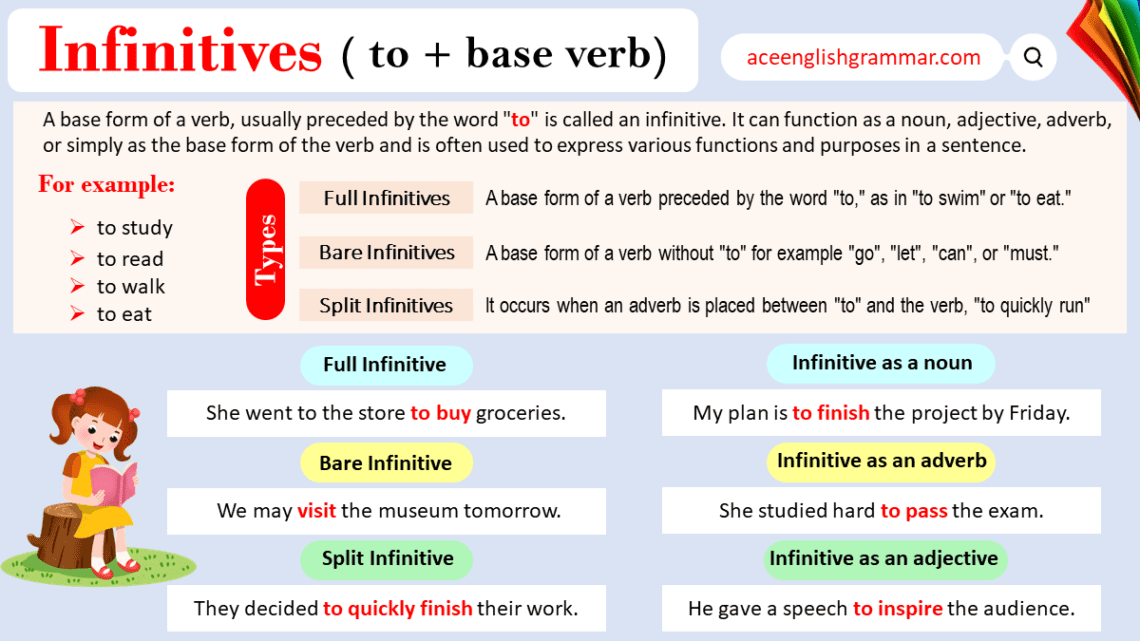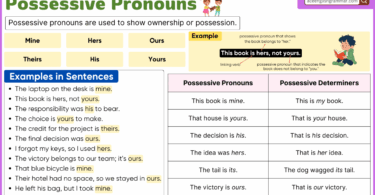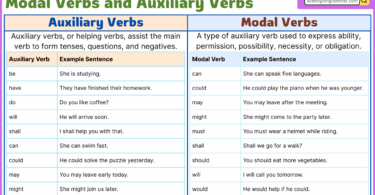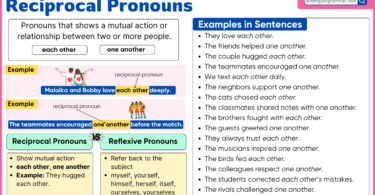An infinitive is the base form of a verb usually preceded by “to.” It does not show tense or subject but functions like a noun, adjective, or adverb. Infinitives help form clear sentences and express purpose, intention, or possibility. Learning how to use infinitives correctly builds sentence clarity and supports writing and speaking accuracy. In this blog post, you’ll learn the forms, structures, and rules of infinitives step by step.
Table of Contents
What is an Infinitive?
An infinitive is the basic form of a verb. It usually comes with “to” and does not show time, person, or tense.
Common Infinitives:
- to read
- to eat
- to play
- to go
Formation of Infinitives
Infinitives are formed by using the base form of a verb, typically preceded by the word “to. They are easily recognizable due to their distinctive structure: “to + base form of the verb.” This structure remains consistent regardless of the subject or tense of the sentence. Whether it’s “They want to travel” or “She wants to travel,” the infinitive structure remains the same.
To + Base Form of the Verb
For example:
- To eat
- To run
- To study
- To write
- To walk
Types of Infinitives in English Grammar
Infinitives can be categorized into four main types based on how they function in a sentence. Each has a specific structure and use case.
1. Bare Infinitive
A bare infinitive is the base form of the verb without “to”. It’s used after modal verbs (can, must, should, etc.) and certain verbs like make, let, help, see, and hear.
Examples:
- You must go now.
- He made me laugh.
- Please sit here.
2. To-Infinitive
The to-infinitive is the most common form. It uses “to” + base verb. It appears after many verbs, adjectives, nouns, and in fixed phrases.
Examples:
- He wants to travel.
- She likes to play badminton.
- They tried to convince her.
3. Split Infinitive
A split infinitive happens when an adverb is placed between “to” and the verb. This form is widely accepted in modern English, especially to add clarity or emphasis.
Examples:
- She decided to quickly finish her work.
- He wanted to carefully examine the case.
- They tried to quietly leave the room.
4. Passive Infinitive
In a passive infinitive, the structure is “to be” + past participle. It shifts the focus to the action, not the person doing it.
Examples:
- It’s important to be understood.
- She wants to be invited.
- The car is to be repaired.
Types of Infinitives with Usage and Structure
| Infinitive Type | Structure | Usage | Example Sentence |
|---|---|---|---|
| Present Infinitive | to + base verb | Shows present or general actions | I like to eat pizza. |
| Past Infinitive | to have + past participle | Refers to actions completed in the past | She claimed to have seen a ghost. |
| Future Infinitive | to + base verb (with future marker) | Implies future action using context/time marker | I will call you tomorrow. |
| Perfect Infinitive | to have + past participle | Emphasizes completed actions before another | He was happy to have finished work. |
| Continuous Infinitive | to be + present participle | Expresses ongoing actions in a time frame | He seems to be studying all night. |
Functions of Infinitives in Sentences
Infinitives can act as nouns, adjectives, or adverbs depending on how they are used.
1. As a Noun
Infinitives work like nouns. They can be the subject, object, or part of a phrase.
Examples:
- To travel is my dream. (Subject)
- She loves to read. (Object)
- He has a desire to succeed. (Object of preposition)
2. As an Adjective
Infinitives can describe nouns and tell which one or what kind.
Examples:
- The book to read is on the shelf.
- The decision to resign was hard.
3. As an Adverb
Infinitives can tell why, how, or for what purpose an action happens.
Examples:
- I woke up early to catch the bus.
- She studies hard to succeed.
- He worked late to finish the task.
Infinitives vs Gerunds
| Aspect | Gerund | Infinitive |
|---|---|---|
| Form | Verb + -ing (e.g., reading) | To + base verb (e.g., to read) |
| Grammatical Role | Acts as a noun | Acts as a noun, adjective, or adverb |
| Common Usage | Refers to general actions/activities | Often shows purpose or intention |
| Used After | Certain verbs, prepositions, as subject/object | Certain verbs, adjectives, as subject/object |
| Example | Swimming is healthy. | I want to swim. |
| Meaning Change | ✅ He stopped smoking → Quit the habit | ✅ He stopped to smoke → Took a break to smoke |
Infinitive Phrases
Infinitives can appear as part of larger structures known as infinitive phrases. An infinitive phrase consists of an infinitive and any associated words that modify or complement it. Infinitive phrases can function as nouns, adjectives, or adverbs in a sentence.
Here are some examples of infinitive phrases:
- To study hard is the key to success.
- She loves to read books in her free time.
- He worked late to finish the project on time.
In each of these examples, the infinitive phrase is highlighted and its function is explained.
Examples of Infinitives
- He studies hard to pass his exams.
- They want to go on a vacation.
- Please let me help
- He wants to travel to Europe.
- I like to swim in the morning.
- I will eat lunch later.
- He decided to quickly finish the project.
- She ran fast to catch the bus.
- His main goal is to succeed.
- My dream is to travel the world.
- She wanted to quietly leave the room.
- He will arrive
- They can’t wait to see the movie.
- The gift is too expensive to buy.
- He spoke softly to avoid waking the baby.
FAQs
Q1: What is an infinitive?
An infinitive is the base form of a verb, usually preceded by the word “to” in English. It can function as a noun, adjective, adverb, or simply as the base form of the verb. It is often used to express various functions and purposes in a sentence.
Q2: What are split infinitives?
Split infinitives occur when an adverb is placed between “to” and the base form of the verb (e.g., “to quickly learn”). While they were traditionally avoided in formal writing, modern English often accepts split infinitives when they enhance clarity or emphasis.
Q3: How do infinitives differ from gerunds?
Infinitives are the base form of a verb and are typically preceded by “to,” while gerunds are verbs in their -ing form and function as nouns. Infinitives often express intention or purpose, whereas gerunds represent an action.
Q4: When should I use a bare infinitive?
Use a bare infinitive after modal verbs (e.g., can, will, must), certain other verbs (e.g., make, let, have), and as the base form of a verb in various sentences. For example, “She can swim” (modal verb), and “He made her laugh” (after the verb “make”).
Q5: What is the zero infinitive?
The zero infinitive is the base form of a verb used without “to” in certain constructions. It is often found after verbs like “let,” “make,” and “help.” For example, “Let me go,” “She made him laugh.”
Q6: Give some example sentences of infinitives.
Here are some examples of infinitives:
- He should study harder for the exam.
- To travel is her lifelong dream.
- I hope to see you at the party.
- Please sit down and relax.
- His goal is to win the championship.
Conclusion
infinitives are an essential part of English grammar, serving as nouns, adjectives, or adverbs. They are classified into to-infinitives (to learn, to write) and bare infinitives (let go, help do). Mastering their usage enhances sentence structure, clarity, and fluency in both writing and speech.
Read more




